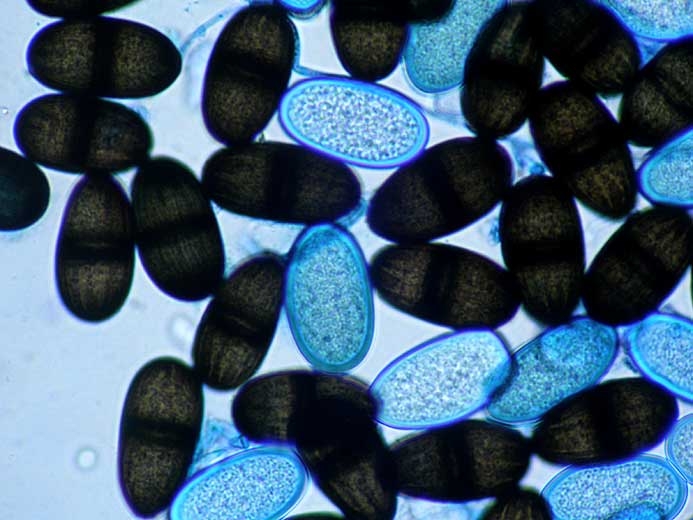
Lasiodiplodia theobromae
(Pat.) Griffon & Maubl., (1909)
- classification : Fungi, Ascomycota, Dothideomycetes, Incertae sedis, Botryosphaeriales, Botryosphaeriaceae
- téléomorphe : " Botryosphaeria" rhodina Berk. & M.A. Curtis) Arx
- synonyms: many
- English name: leaf spot disease, melon Lasiodiplodia decline, Lasiodiplodia rot, Lasiodiplodia fruit rot, Diplodia stem-end rot, tropical rot
L. theobromae is a soil fungus mainly responsible under natural conditions for rots and diebacks on various plants, whether or not cultivated, more than 280 species have been reported as susceptible. It is widely distributed in the world since it has been detected in many countries on several continents: Europe, Asia, Africa, the Americas and Oceania. It has thus been observed in France, Spain, India, Pakistan, Brazil, the United States, Cuba, Chile and Australia. It is particularly active in all the countries of the tropics and subtropics.
Many species of Cucurbitaceae are susceptible to L. theobromae although this fungus does not presently pose a significant threat to this botanical family. It has been reported to be responsible for various rots on fruits and seeds before or after harvest on watermelon, melons honeydew and cantaloupe, calabash ( Lagenaria siceraria ), pumpkin, squash, bitter gourd ( Momordica charantia ), loofah ( Luffa aegyptiaca ).
Main symptoms
L. theobromae seems capable of attacking all the aerial organs of Cucurbitaceae, although it is mainly reported on fruits and seeds. Symptoms on other organs should be considered very occasional.
On the seeds , it is responsible for black rots, in particular on calabash, deeply affecting the tissues of the cotyledons and the embryo. Subsequently, this fungus can cause damping-off in pre- and post-emergence.
Of leaf spots greenish-yellow to dark brown was observed on loofah, and calabash.
This fungus is also thought to cause brown, gummy lesions on stems quite similar to those caused by Didymella bryoniae . Different types of melon and watermelon are particularly affected. Leaf wilting and drying out are believed to be associated with these lesions on the stems.
Rots on flowers and on fruits mature or not mature were observed on loofah, watermelons, different types of melon , gourd, calabash Lesions on fruits often begin at the level of the stalk scar; colonized tissues soften, rot and turn brown more or less.
Biology, epidemiology
- Conservation, sources d'inoculum
L. theobromae survives in the soil on plant debris and on infected seeds. It has been found in particular on the seeds of gourds, pumpkin, melon, colocynth, squash The latter can constitute a significant source of primary inoculum. For example, L. theobromae can survive for 12 months on severely infected calabash seeds. In fact, its survival would depend on the level of infection of the seeds. It would last for 7 months on squash seeds. Its mycelium and its pycnidia would notably ensure its conservation.
Note that a significant number of alternative hosts are likely to host and conserve it: pepper, eggplant, spinach, sweet potato, okra, yam, cassava, apple tree, pear tree, fig tree, papaya tree, guava tree, mango tree, wheat, corn, sunflower, peanut, oil palm, cotton
- Penetration, invasion
This fungus seems to be able to behave with regard to Cucurbitaceae either as a real parasite directly penetrating the tissues, or as an opportunist settling on organs in a poor physiological state and / or injured, or already infected by other pests. .
Once in place, it colonizes fairly quickly the tissues that it causes to rot.
- Sporulation and dissemination
It produces black pycnidia on colonized tissues, rather round and containing one or more cavities. Conidia are formed inside; they are initially hyaline, unicellular, ovoid to ellipsoid, and have a thin wall. As they age, they take on a dark brown hue, become compartmentalized and become bicellular, and exhibit longitudinal streaks.
These spores are mainly disseminated during the day by drafts, rains and sprinkler irrigation.
- Conditions favorable to its development
L. theobromae seems to prefer rather high temperatures above 25 ° C. Its development is greatly reduced at 10 ° C. Very rainy periods are particularly favorable to its parasitism.
Protection methods
Given the low incidence of this fungus on Cucurbitaceae, no special protection is necessary. In the few subtropical and tropical areas where this fungus causes problems, it will be advisable to implement the following measures:
- use healthy seeds. These will in no case, for the sake of economy, recovered from rotten fruit;
- set up rotations that do not involve susceptible hosts;
- harvest the fruits with the greatest care in order to limit as much as possible the risks of mechanical injuries conducive to contamination;
- quickly eliminate the first diseased plants or the first rotten fruits. For this, the diseased organs will be placed in a plastic bag to avoid any contact with healthy plants, and they will be quickly destroyed;
- at the end of cultivation, remove plant debris or bury them very deeply so that they decompose quickly.
* Chemical control : As the number of pesticides available for a given use is constantly changing, we advise you to always confirm your choice by consulting the e-phy site of the Ministry of Agriculture and Fisheries which is an online catalog of plant protection products and their uses, fertilizers and growing media approved in France. This also applies to all biological products based on microorganisms or natural substances.





